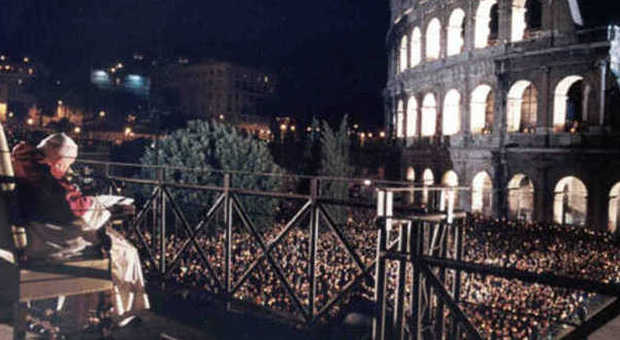The interest, the love for Man, the central point of what the Polish teach are, I believe, what brings us closer together, makes the distinction, between my way of living and responding and Kantor’s and, with the necessary difference, that of a great Pope like Wojtyla. The figures in my sculptures, often only pieces of a body which refer the whole of man to Utopia, steeped in contemporaneity, find in Wojtyla a perfect echo. The Pope loved the Eternal City, historic Rome, the ruins, the artists. Rome of emphatic physicality and beautiful soul. The two things, in this city, are often the same. The physicality of Rome is immeasurable, touchable, pulsing. Also on the linguistic plane. And its soul is open to the world which Wojtyla, in the course of his long pontifical reign, exalted to the maximum.
The Pope who came from the East, who loved and met with artists, wished and learned to know Urbe better than many others. Rome is chaotic and beautiful. The only place on earth where Beauty and Ugliness live without the desire to subjugate the other, or perhaps setting up the absurd sublime that ugly becomes beautiful and vice-a-versa. In Rome you are aware of the power the city had on the world. Also spiritual. The Pantheon, the monument which to me is superior to any other, is a combined expression of perfection, the union of beautiful and good, affirmation of power together with spirituality. And finally it is linked by name to an ideal Roman, the Emperor Hadrian, the epitome of command and culture, science and philosophy, certainty and the search for Truth.
Wojtyla, lover of art, poetry and theatre, was well aware of all this. He saw and appreciated the shaded white of the travertine, the red of the bricks, the bronze, gold, silver, blue, yellow ochre and green stippled in the hard stones with which the texture of mosaics is made, the orange of the sunset over the Appia, the bronze-green of the sediment in the fountains of iron water, the blonde grey of the Tiber …
Perhaps when the young Karol arrived in Rome (at least I like to think so) the route that he took after getting off the train was the same as me when I arrived in the capital from Paris. From the Terminal Station to Santa Maria degli Angeli, then, always on foot, a visit to Michelangelo’s Moses, on down to the Santa Maria sopra Minerva, where there’s the magnificent Christ by Buonarroti, and finally Sant’Ignazio, to admire the amazing altar of inlaid marble. Without noticing the traffic, the tourists, the pollution, happy to be surrounded by the sublime mixture of marvels and horror that the Eternal City diffuses minute by minute. Rome is truly proud of the great Pole who wanted to be called by the name of two apostles, that of love and that of preaching to people.
Translation by Antoinette Canini
© All rights reserved
© RIPRODUZIONE RISERVATA
